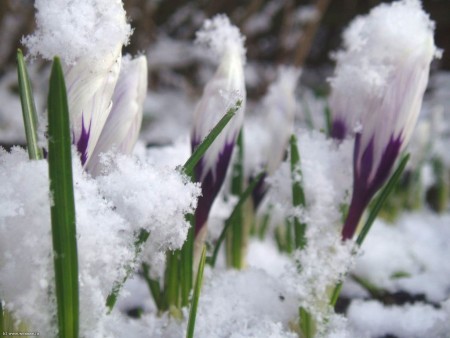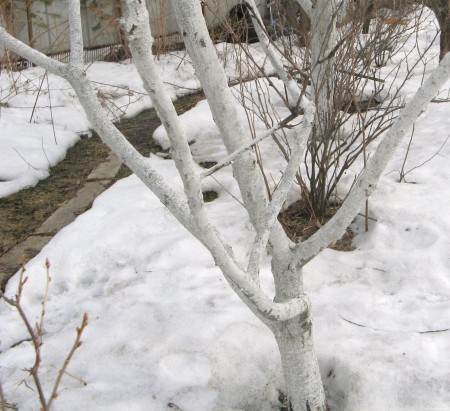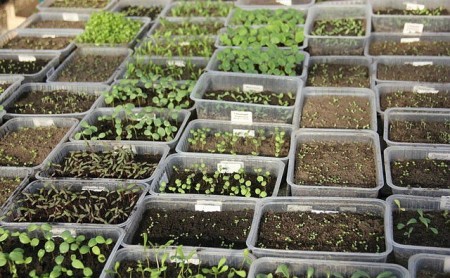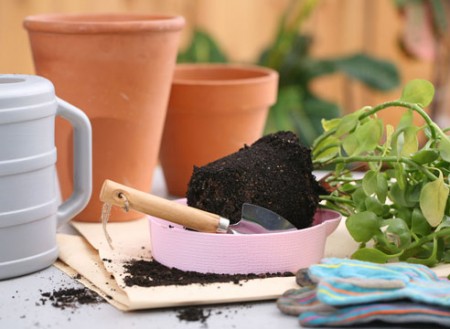Article from the section “Calendar of work for gardeners and vegetable gardeners.”
The beginning of calendar spring does not always bring long-awaited warmth, but most flower growers greet the first morning in March in high spirits: “We’ve waited!”
What kind of work awaits flower growers in March?
Your flower garden: work of the month.
And even if spring is only in our thoughts, we are already in a different mood, rushing to the store to choose seeds and bulbs.We more enthusiastically encourage the elongated February flower seedlings: just be patient a little longer, soon you will be showing off in the flower beds.
In March, I can’t wait to visit the garden to make sure that all the plants have wintered safely. I would like to quickly get rid of the winter mess in flower beds, remove cover from perennials, loosen the soil, and feed the plants.
My hands miss the earth, my eyes miss the flowers, I want to work. And in order for the garden to greet spring cozy and tidy, you will have to work hard.
It's time to start pruning in March.
But the desire to do everything quickly should be reasonable. You should not trim the stems of herbaceous perennials left over from the fall by crawling on thawed, soggy soil: we will do more harm to the garden than good.
At the beginning of March, there will still be days with sub-zero temperatures when you can start “trimming” ornamental shrubs: cutting out dry, broken crowns growing inwards and thickening shoots.
When giving shape to shrubs, do not forget about the shoots of what year they bloom. You cannot shorten shrubs that bloom on last year's shoots, for example, forsythia: you can cut off the entire flowering part. But let’s not stand on ceremony with hedges: the more pruning, the more magnificent and voluminous the “green fence” will be in the spring.
Leaves also need to be raked wisely
We don’t try to rake up leaves and mulch that warms the soil all over the garden at once. First of all, we will clear the root zone of coniferous trees so that the soil under the crowns warms up faster and the roots begin to work.
Frozen soil can even be shed with warm water. “Cold” in the root zone threatens spring needle burns.Having warmed up in the sun, the conifers come to life, but, not receiving nutrition or water from the idle frozen roots, they die.
In March, leaves can also be raked from the area where tulips, daffodils, and hyacinths are planted. The faster the soil warms up, the sooner the bulbous plants will bloom. The cool weather of mid-spring is favorable for their flowering.
When the soil warms, the mulch material can be returned to the flower beds, protecting the bulbs and roots from overheating.
We do not keep roses under cover for a long time: short-term moderate frosts in March are not as dangerous for them as excessive humidity under cover. Gradually removing the “winter clothes” from the bushes, we will protect the roses from the sun with non-woven material.
First March sowings
As soon as the soil allows, we will begin sowing cold-hardy annuals.
- annual asters
- Snapdragon
- Eschsolzia
- calendula
- cornflowers
These flowers germinate better when sown early in the spring. And there is nothing strange in this, because they are sown before winter. After sowing, it is advisable to cover the flower garden with film or non-woven material, not so much to increase the temperature in the seeding area, but to maintain the humidity necessary for their germination.
It is especially important to cover crops on sandy soils, which quickly lose moisture even in early spring. For the same reason, seeds on light soils are planted deeper than on heavy soils. We will sow more heat-loving annuals (zinnias, balsam, morning glory, etc.) in April-May.
Early, March sowing of annuals in the garden will save us from the abundance of annual seedlings on the windowsill. Although we won’t completely give up growing our favorite flowers in the room.
- Tagetes
- Snapdragon
- lobelia
- Iberis
Having begun their life journey on the windowsill, they will bloom earlier than their ground relatives, the peak of their decorativeness will come later.
In March we sow annuals on the windowsill
Let's sow annuals at home, if only because the March sun allows us to grow seedlings without additional lighting, which makes our work much easier.
We will not add humus to the soil mixture, so as not to provoke the development of blackleg on the seedlings. And we will sow rarely for the same reason.
The depth of planting of seeds depends on their size: the larger the seeds, the deeper the sowing.
- Small seeds of ageratum, snapdragon, lobelia, petunia, and fragrant tobacco are simply scattered on the damp surface of the soil or lightly sprinkled with calcined sand and covered with film.
- The seeds of sweet peas and nasturtium, so that they germinate faster, are soaked in water for a day (+25 +30 degrees), and then kept in a damp cloth until they hatch.
- Ageratum, lobelia, godetia, sweet pea, snapdragon, annual aster germinate best in a cool place (12-15 degrees). Accordingly, the seedlings of these plants will feel better in a cool microclimate.
For seed germination of most annuals, the optimal temperature is 18-20 degrees.
When growing seedlings, we take into account other plant characteristics:
- Sowing dahlias, sweet peas, and lobelia do not like dry soil and air. We not only water them regularly, preventing the soil from drying out, but also spray them.
- Tagetes, ageratum, annual asters, carnations, petunia, phlox, chrysanthemums are watered only after the soil surface has dried.
How to care for flower seedlings
Feeding. We feed flower seedlings with complex mineral fertilizers dissolved in water (1-2 g per liter of water). After fertilizing, be sure to water the plants and wash their leaves to wash off the fertilizer and avoid burns.
Picking. We plant dense shoots of ornamental plants already at the stage of one true leaf. If this is not done, the plants will stretch out in search of light; poor ventilation can cause the development of fungal diseases.
Rare seedlings can be picked at the stage of 2-3 true leaves. But we immediately sow sweet peas, matthiola, nasturtium in separate cups, pots, cassettes, so as not to disturb them with transplanting (they don’t like this).
Seedlings sown with their own seeds (we always collect a lot of them) can simply be thinned out, increasing the distance between plants to 4-5 cm. Later, you can thin out again, removing weak plants.
Experiments. Those who like to experiment can try out the cooling method. Seedlings of zinnia, petunia, tagetes at the stage of 2-4 true leaves are kept for two weeks at low temperatures above zero (take them out onto the loggia) so that they bloom faster.
We are updating our assortment. So that the garden in the coming season does not look like last year’s, you can update the assortment of annuals by purchasing seeds of annuals that are new to us in the store.
And these do not necessarily have to be new plant species. It is enough to expand the range of flowers that we have learned to grow. Tagetes rejected should be supplemented with thin-leaved ones; to the tall varieties of snapdragons, add more miniature ones, which can create a picturesque border in the summer that blooms until late autumn.
Instead of traditional zinnias, sow Japanese ones: they look more graceful, neater and bloom more abundantly than the more familiar “majors”.
When working in the garden, don’t forget about your pets.
When working with flower beds in the garden, let's not forget about indoor flowers. Over the winter, many of them have stretched out and do not look as lush and neat as in the summer.
We trim long branches and pin the growing points of the rest to encourage the growth of side shoots. We will definitely replant the plants that have “grown out of their pots”.
March is the time to replant flowers
The fact that the flower needs to be urgently replanted is indicated by the roots appearing in the drainage holes, the quickly drying soil lump (you have to water almost every day), the general condition of the plants (yellowing and falling leaves, drying out shoots, etc.).
Having shaken the root ball out of the pot, trim off the dead roots and gently loosen the ball with a stick. If we do not cut off the roots or crown of the transplanted flower much, then the new pot for it should be 2-4 cm wider than the previous one.
For a heavily pruned plant, we do not increase the volume of the pot. In this way, you can keep very growing plants within “certain limits.”
Each pot must have drainage. In a small container, it is enough to cover the drainage hole with a shard, but the larger the pot, the more thorough the drainage layer: a layer of clay shards or expanded clay, coarse sand, pieces of charcoal.
If the roots of the flower are healthy and we want it to continue to actively grow, we can get by with transshipment. We shake the plant out of the pot and, without disturbing the root ball, transfer it to a larger pot. Fill the space between the root ball and the walls of the pot with fresh soil mixture, compacting it with a stick.Then we water the overloaded plant abundantly.
Young flowers need annual replanting. Old overgrown plants are not replanted every year, but the top layer of soil in the tubs is replaced.
We shade the transplanted and transshipped flowers for some time and water them very sparingly. We begin feeding after the plants resume growth. To ensure that the flowers receive everything they need, it is better to use complex fertilizers (1 g per liter of water).
In March it is already possible to engage in rejuvenation and plant propagation. The shoots remaining after pruning will be suitable for cuttings, which we will root in water or in clean sand, covered with film or some kind of transparent “cap”. Cuttings need light, but we still protect them from direct sunlight.
As you can see, in March there is no time for flower growers to be bored, and in April there will be even more work.







 (13 ratings, average: 4,54 out of 5)
(13 ratings, average: 4,54 out of 5) CUCUMBERS NEVER GET SICK, I'VE BEEN USING ONLY THIS FOR 40 YEARS! I SHARE A SECRET WITH YOU, CUCUMBERS ARE LIKE THE PICTURE!
CUCUMBERS NEVER GET SICK, I'VE BEEN USING ONLY THIS FOR 40 YEARS! I SHARE A SECRET WITH YOU, CUCUMBERS ARE LIKE THE PICTURE! You can dig a bucket of potatoes from each bush. Do you think these are fairy tales? Watch the video
You can dig a bucket of potatoes from each bush. Do you think these are fairy tales? Watch the video
 How our fellow gardeners work in Korea. There is a lot to learn and just fun to watch.
How our fellow gardeners work in Korea. There is a lot to learn and just fun to watch. Eye trainer.The author claims that with daily viewing, vision is restored. They don't charge money for views.
Eye trainer.The author claims that with daily viewing, vision is restored. They don't charge money for views. A 3-ingredient cake recipe in 30 minutes is better than Napoleon. Simple and very tasty.
A 3-ingredient cake recipe in 30 minutes is better than Napoleon. Simple and very tasty. Therapeutic exercises for cervical osteochondrosis. A complete set of exercises.
Therapeutic exercises for cervical osteochondrosis. A complete set of exercises. Which indoor plants match your zodiac sign?
Which indoor plants match your zodiac sign? What about them? Excursion to German dachas.
What about them? Excursion to German dachas.